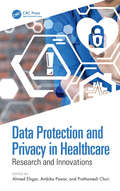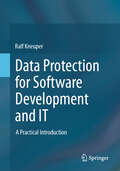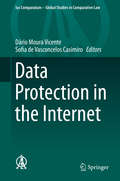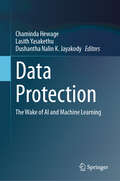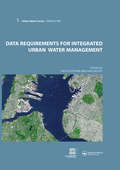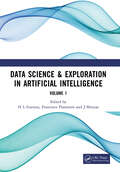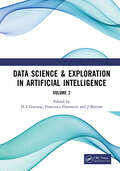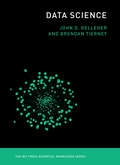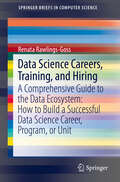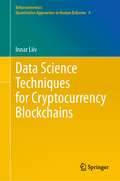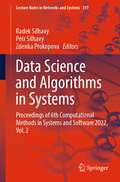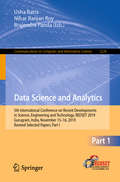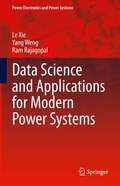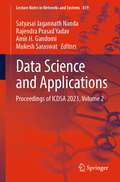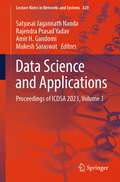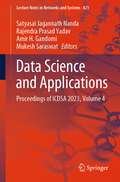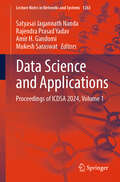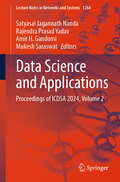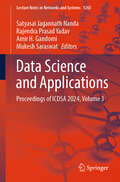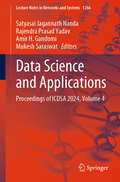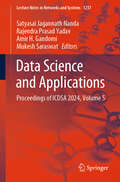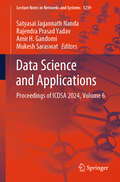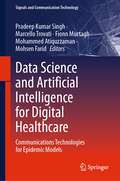- Table View
- List View
Data Protection and Privacy in Healthcare: Research and Innovations
by Ahmed Elngar, Ambika Pawar, and Prathamesh ChuriThe Healthcare industry is one of the largest and rapidly developing industries. Over the last few years, healthcare management is changing from disease centered to patient centered. While on one side the analysis of healthcare data plays an important role in healthcare management, but on the other side the privacy of a patient’s record must be of equal concern. This book uses a research-oriented approach and focuses on privacy-based healthcare tools and technologies. It offers details on privacy laws with real-life case studies and examples, and addresses privacy issues in newer technologies such as Cloud, Big Data, and IoT. It discusses the e-health system and preserving its privacy, and the use of wearable technologies for patient monitoring, data streaming and sharing, and use of data analysis to provide various health services. This book is written for research scholars, academicians working in healthcare and data privacy domains, as well as researchers involved with healthcare law, and those working at facilities in security and privacy domains. Students and industry professionals, as well as medical practitioners might also find this book of interest.
Data Protection for Software Development and IT: A Practical Introduction
by Ralf KneuperThis book introduces data protection, i.e. the protection of individuals from misuse of their personal data. It provides a special focus on the direct impact on software development, e.g. in the form of functional requirements for software systems resulting from data protection. Chapter 1 provides an initial overview of the basic concepts of data protection and its legal foundations. Chapter 2 then delves deeper into the European General Data Protection Regulation (GDPR), covering in particular its basic concepts, terminology and requirements. Next, the specific implementation and interpretation of GDPR requirements in software and IT are dealt with, starting in chapter 3 with the principles of data protection defined in GDPR and the rights of data subjects in chapter 4. Chapter 5 discusses data transfer between organizations, including the relevant constellations (e.g. through various service providers), the legal framework and its practical implementation. Subsequently, chapter 6 changes the view from individual regulations and their implementation to technical and organizational design of data protection, including its embedding in the software life cycle, while chapter 7 provides an overview of information security and its aspects relevant to data protection. Eventually, chapter 8 deals with data protection for organizations as they are data subjects themselves. The appendices contain the most important excerpts from the Charter of Fundamental Rights of the EU and GDPR in this context, a collection of links to relevant laws and supervisory authorities, as well as a glossary of the most important terms used. The book’s target groups include software developers, IT consultants, requirements analysts, IT operations personnel and project managers in IT projects, but also data protection managers and data protection officers in the context of software development and IT.
Data Protection in the Internet (Ius Comparatum - Global Studies in Comparative Law #38)
by Dário Moura Vicente Sofia de Vasconcelos CasimiroThis book identifies and explains the different national approaches to data protection – the legal regulation of the collection, storage, transmission and use of information concerning identified or identifiable individuals – and determines the extent to which they could be harmonised in the foreseeable future. In recent years, data protection has become a major concern in many countries, as well as at supranational and international levels. In fact, the emergence of computing technologies that allow lower-cost processing of increasing amounts of information, associated with the advent and exponential use of the Internet and other communication networks and the widespread liberalization of the trans-border flow of information have enabled the large-scale collection and processing of personal data, not only for scientific or commercial uses, but also for political uses. A growing number of governmental and private organizations now possess and use data processing in order to determine, predict and influence individual behavior in all fields of human activity. This inevitably entails new risks, from the perspective of individual privacy, but also other fundamental rights, such as the right not to be discriminated against, fair competition between commercial enterprises and the proper functioning of democratic institutions. These phenomena have not been ignored from a legal point of view: at the national, supranational and international levels, an increasing number of regulatory instruments – including the European Union’s General Data Protection Regulation applicable as of 25 May 2018 – have been adopted with the purpose of preventing personal data misuse. Nevertheless, distinct national approaches still prevail in this domain, notably those that separate the comprehensive and detailed protective rules adopted in Europe since the 1995 Directive on the processing of personal data from the more fragmented and liberal attitude of American courts and legislators in this respect. In a globalized world, in which personal data can instantly circulate and be used simultaneously in communications networks that are ubiquitous by nature, these different national and regional approaches are a major source of legal conflict.
Data Protection: The Wake of AI and Machine Learning
by Dushantha Nalin K. Jayakody Chaminda Hewage Lasith YasakethuThis book provides a thorough and unique overview of the challenges, opportunities and solutions related with data protection in the age of AI and ML technologies. It investigates the interface of data protection and new technologies, emphasising the growing need to safeguard personal and confidential data from unauthorised access and change. The authors emphasize the crucial need of strong data protection regulations, focusing on the consequences of AI and ML breakthroughs for privacy and individual rights. This book emphasizes the multifarious aspect of data protection, which goes beyond technological solutions to include ethical, legislative and societal factors. This book explores into the complexity of data protection in the age of AI and ML. It investigates how massive volumes of personal and sensitive data are utilized to train and develop AI models, demanding novel privacy-preserving strategies such as anonymization, differential privacy and federated learning. The duties and responsibilities of engineers, policy makers and ethicists in minimizing algorithmic bias and ensuring ethical AI use are carefully defined. Key developments, such as the influence of the European Union's General Data Protection Regulation (GDPR) and the EU AI Act on data protection procedures, are reviewed critically. This investigation focusses not only on the tactics used, but also on the problems and successes in creating a secure and ethical AI ecosystem. This book provides a comprehensive overview of the efforts to integrate data protection into AI innovation, including valuable perspectives on the effectiveness of these measures and the ongoing adjustments required to address the fluid nature of privacy concerns. This book is a helpful resource for upper-undergraduate and graduate computer science students, as well as others interested in cybersecurity and data protection. Researchers in AI, ML, and data privacy as well as data protection officers, politicians, lawmakers and decision-makers will find this book useful as a reference.
Data Requirements for Integrated Urban Water Management: Urban Water Series - UNESCO-IHP (Urban Water Series)
by Tim D. Fletcher and Ana DeletiicIntegrated urban water management relies on data allowing us to analyse, understand and predict the behaviour of the individual water cycle components and their interactions. The concomitant monitoring of the complex of urban water system elements makes it possible to grasp the entirety of relations among the various components of the urban water c
Data Scheduling and Transmission Strategies in Asymmetric Telecommunication Environments
by Abhishek Roy Navrati SaxenaThis book presents a framework for a new hybrid scheduling strategy for heterogeneous, asymmetric telecommunication environments. It discusses comparative advantages and disadvantages of push, pull, and hybrid transmission strategies, together with practical consideration and mathematical reasoning.
Data Science & Exploration in Artificial Intelligence: Proceedings of the First International Conference On Data Science & Exploration in Artificial Intelligence (CODE-AI 2024) Bangalore, India, 3rd- 4th July, 2024 (Volume 1)
by Francesco Flammini H. L. Gururaj J. ShreyasThe book captures the essence of the International Conference on Data Science & Exploration in Artificial Intelligence and offers a comprehensive exploration of cutting-edge research in AI, data science, and their applications.It covers a wide array of topics including advanced Data Science, IoT, Security, Cloud Computing, Networks, Security, Image, Video and Signal Processing, Computational Biology, Computer and Information Technology. It highlights innovative research contributions and practical applications, offering readers a detailed understanding of current trends and challenges. The findings emphasize the role of global collaboration and interdisciplinary approaches in pushing the boundaries of AI and data science. Selected papers published by Taylor and Francis showcase pioneering work that is shaping the future of these fields.This is an ideal read for AI and data science researchers, industry professionals, and students seeking to stay updated on the latest advancements and ethical considerations in these areas.
Data Science & Exploration in Artificial Intelligence: Proceedings of the First International Conference On Data Science & Exploration in Artificial Intelligence (CODE-AI 2024) Bangalore, India, 3rd- 4th July, 2024 (Volume 2)
by Francesco Flammini H. L. Gururaj J. ShreyasThe book captures the essence of the International Conference on Data Science & Exploration in Artificial Intelligence and offers a comprehensive exploration of cutting-edge research in AI, data science, and their applications.It covers a wide array of topics including advanced Data Science, IoT, Security, Cloud Computing, Networks, Security, Image, Video and Signal Processing, Computational Biology, Computer and Information Technology. It highlights innovative research contributions and practical applications, offering readers a detailed understanding of current trends and challenges. The findings emphasize the role of global collaboration and interdisciplinary approaches in pushing the boundaries of AI and data science. Selected papers published by Taylor and Francis showcase pioneering work that is shaping the future of these fields.This is an ideal read for AI and data science researchers, industry professionals, and students seeking to stay updated on the latest advancements and ethical considerations in these areas.
Data Science (The MIT Press Essential Knowledge series)
by John D. Kelleher Brendan TierneyA concise introduction to the emerging field of data science, explaining its evolution, relation to machine learning, current uses, data infrastructure issues, and ethical challenges.The goal of data science is to improve decision making through the analysis of data. Today data science determines the ads we see online, the books and movies that are recommended to us online, which emails are filtered into our spam folders, and even how much we pay for health insurance. This volume in the MIT Press Essential Knowledge series offers a concise introduction to the emerging field of data science, explaining its evolution, current uses, data infrastructure issues, and ethical challenges.It has never been easier for organizations to gather, store, and process data. Use of data science is driven by the rise of big data and social media, the development of high-performance computing, and the emergence of such powerful methods for data analysis and modeling as deep learning. Data science encompasses a set of principles, problem definitions, algorithms, and processes for extracting non-obvious and useful patterns from large datasets. It is closely related to the fields of data mining and machine learning, but broader in scope. This book offers a brief history of the field, introduces fundamental data concepts, and describes the stages in a data science project. It considers data infrastructure and the challenges posed by integrating data from multiple sources, introduces the basics of machine learning, and discusses how to link machine learning expertise with real-world problems. The book also reviews ethical and legal issues, developments in data regulation, and computational approaches to preserving privacy. Finally, it considers the future impact of data science and offers principles for success in data science projects.
Data Science Careers, Training, and Hiring: A Comprehensive Guide to the Data Ecosystem: How to Build a Successful Data Science Career, Program, or Unit (SpringerBriefs in Computer Science)
by Renata Rawlings-GossThis book is an information packed overview of how to structure a data science career, a data science degree program, and how to hire a data science team, including resources and insights from the authors experience with national and international large-scale data projects as well as industry, academic and government partnerships, education, and workforce. Outlined here are tips and insights into navigating the data ecosystem as it currently stands, including career skills, current training programs, as well as practical hiring help and resources. Also, threaded through the book is the outline of a data ecosystem, as it could ultimately emerge, and how career seekers, training programs, and hiring managers can steer their careers, degree programs, and organizations to align with the broader future of data science. Instead of riding the current wave, the author ultimately seeks to help professionals, programs, and organizations alike prepare a sustainable plan for growth in this ever-changing world of data. The book is divided into three sections, the first “Building Data Careers”, is from the perspective of a potential career seeker interested in a career in data, the second “Building Data Programs” is from the perspective of a newly forming data science degree or training program, and the third “Building Data Talent and Workforce” is from the perspective of a Data and Analytics Hiring Manager. Each is a detailed introduction to the topic with practical steps and professional recommendations. The reason for presenting the book from different points of view is that, in the fast-paced data landscape, it is helpful to each group to more thoroughly understand the desires and challenges of the other. It will, for example, help the career seekers to understand best practices for hiring managers to better position themselves for jobs. It will be invaluable for data training programs to gain the perspective of career seekers, who they want to help and attract as students. Also, hiring managers will not only need data talent to hire, but workforce pipelines that can only come from partnerships with universities, data training programs, and educational experts. The interplay gives a broader perspective from which to build.
Data Science Techniques for Cryptocurrency Blockchains
by Innar LiivThis book brings together two major trends: data science and blockchains. It is one of the first books to systematically cover the analytics aspects of blockchains, with the goal of linking traditional data mining research communities with novel data sources. Data science and big data technologies can be considered cornerstones of the data-driven digital transformation of organizations and society. The concept of blockchain is predicted to enable and spark transformation on par with that associated with the invention of the Internet. Cryptocurrencies are the first successful use case of highly distributed blockchains, like the world wide web was to the Internet. <P><P> The book takes the reader through basic data exploration topics, proceeding systematically, method by method, through supervised and unsupervised learning approaches and information visualization techniques, all the way to understanding the blockchain data from the network science perspective. <P><P> Chapters introduce the cryptocurrency blockchain data model and methods to explore it using structured query language, association rules, clustering, classification, visualization, and network science. Each chapter introduces basic concepts, presents examples with real cryptocurrency blockchain data and offers exercises and questions for further discussion. Such an approach intends to serve as a good starting point for undergraduate and graduate students to learn data science topics using cryptocurrency blockchain examples. It is also aimed at researchers and analysts who already possess good analytical and data skills, but who do not yet have the specific knowledge to tackle analytic questions about blockchain transactions. The readers improve their knowledge about the essential data science techniques in order to turn mere transactional information into social, economic, and business insights.
Data Science and Algorithms in Systems: Proceedings of 6th Computational Methods in Systems and Software 2022, Vol. 2 (Lecture Notes in Networks and Systems #597)
by Radek Silhavy Petr Silhavy Zdenka ProkopovaThis book offers real-world data science and algorithm design topics linked to systems and software engineering. Furthermore, articles describing unique techniques in data science, algorithm design, and systems and software engineering are featured. This book is the second part of the refereed proceedings of the 6th Computational Methods in Systems and Software 2022 (CoMeSySo 2022). The CoMeSySo 2022 conference, which is being hosted online, is breaking down barriers. CoMeSySo 2022 aims to provide a worldwide venue for debate of the most recent high-quality research findings.
Data Science and Analytics: 5th International Conference on Recent Developments in Science, Engineering and Technology, REDSET 2019, Gurugram, India, November 15–16, 2019, Revised Selected Papers, Part I (Communications in Computer and Information Science #1229)
by Brajendra Panda Usha Batra Nihar Ranjan RoyThis two-volume set (CCIS 1229 and CCIS 1230) constitutes the refereed proceedings of the 5th International Conference on Recent Developments in Science, Engineering and Technology, REDSET 2019, held in Gurugram, India, in November 2019. The 74 revised full papers presented were carefully reviewed and selected from total 353 submissions. The papers are organized in topical sections on data centric programming; next generation computing; social and web analytics; security in data science analytics; big data analytics.
Data Science and Applications for Modern Power Systems (Power Electronics and Power Systems)
by Le Xie Yang Weng Ram RajagopalThis book offers a comprehensive collection of research articles that utilize data—in particular large data sets—in modern power systems operation and planning. As the power industry moves towards actively utilizing distributed resources with advanced technologies and incentives, it is becoming increasingly important to benefit from the available heterogeneous data sets for improved decision-making. The authors present a first-of-its-kind comprehensive review of big data opportunities and challenges in the smart grid industry. This book provides succinct and useful theory, practical algorithms, and case studies to improve power grid operations and planning utilizing big data, making it a useful graduate-level reference for students, faculty, and practitioners on the future grid.
Data Science and Applications: Proceedings of ICDSA 2023, Volume 1 (Lecture Notes in Networks and Systems #818)
by Amir H. Gandomi Mukesh Saraswat Rajendra Prasad Yadav Satyasai Jagannath NandaThis book gathers outstanding papers presented at the International Conference on Data Science and Applications (ICDSA 2023), organized by Soft Computing Research Society (SCRS) and Malaviya National Institute of Technology Jaipur, India, from 14 to 15 July 2023. The book is divided into four volumes, and it covers theoretical and empirical developments in various areas of big data analytics, big data technologies, decision tree learning, wireless communication, wireless sensor networking, bioinformatics and systems, artificial neural networks, deep learning, genetic algorithms, data mining, fuzzy logic, optimization algorithms, image processing, computational intelligence in civil engineering, and creative computing.
Data Science and Applications: Proceedings of ICDSA 2023, Volume 2 (Lecture Notes in Networks and Systems #819)
by Amir H. Gandomi Mukesh Saraswat Rajendra Prasad Yadav Satyasai Jagannath NandaThis book gathers outstanding papers presented at the International Conference on Data Science and Applications (ICDSA 2023), organized by Soft Computing Research Society (SCRS) and Malaviya National Institute of Technology Jaipur, India, from 14 to 15 July 2023. The book is divided into four volumes, and it covers theoretical and empirical developments in various areas of big data analytics, big data technologies, decision tree learning, wireless communication, wireless sensor networking, bioinformatics and systems, artificial neural networks, deep learning, genetic algorithms, data mining, fuzzy logic, optimization algorithms, image processing, computational intelligence in civil engineering, and creative computing.
Data Science and Applications: Proceedings of ICDSA 2023, Volume 3 (Lecture Notes in Networks and Systems #820)
by Amir H. Gandomi Mukesh Saraswat Rajendra Prasad Yadav Satyasai Jagannath NandaThis book gathers outstanding papers presented at the International Conference on Data Science and Applications (ICDSA 2023), organized by Soft Computing Research Society (SCRS) and Malaviya National Institute of Technology Jaipur, India, from 14 to 15 July 2023. The book is divided into four volumes, and it covers theoretical and empirical developments in various areas of big data analytics, big data technologies, decision tree learning, wireless communication, wireless sensor networking, bioinformatics and systems, artificial neural networks, deep learning, genetic algorithms, data mining, fuzzy logic, optimization algorithms, image processing, computational intelligence in civil engineering, and creative computing.
Data Science and Applications: Proceedings of ICDSA 2023, Volume 4 (Lecture Notes in Networks and Systems #821)
by Amir H. Gandomi Mukesh Saraswat Rajendra Prasad Yadav Satyasai Jagannath NandaThis book gathers outstanding papers presented at the International Conference on Data Science and Applications (ICDSA 2023), organized by Soft Computing Research Society (SCRS) and Malaviya National Institute of Technology Jaipur, India, from 14 to 15 July 2023. The book is divided into four volumes, and it covers theoretical and empirical developments in various areas of big data analytics, big data technologies, decision tree learning, wireless communication, wireless sensor networking, bioinformatics and systems, artificial neural networks, deep learning, genetic algorithms, data mining, fuzzy logic, optimization algorithms, image processing, computational intelligence in civil engineering, and creative computing.
Data Science and Applications: Proceedings of ICDSA 2024, Volume 1 (Lecture Notes in Networks and Systems #1263)
by Amir H. Gandomi Mukesh Saraswat Rajendra Prasad Yadav Satyasai Jagannath NandaThis book gathers outstanding papers presented at the 5th International Conference on Data Science and Applications (ICDSA 2024), organized by Soft Computing Research Society (SCRS) and Malaviya National Institute of Technology Jaipur, India, from July 17 to 19, 2024. The book is divided into four volumes, and it covers theoretical and empirical developments in various areas of big data analytics, big data technologies, decision tree learning, wireless communication, wireless sensor networking, bioinformatics and systems, artificial neural networks, deep learning, genetic algorithms, data mining, fuzzy logic, optimization algorithms, image processing, computational intelligence in civil engineering, and creative computing.
Data Science and Applications: Proceedings of ICDSA 2024, Volume 2 (Lecture Notes in Networks and Systems #1264)
by Amir H. Gandomi Mukesh Saraswat Rajendra Prasad Yadav Satyasai Jagannath NandaThis book gathers outstanding papers presented at the 5th International Conference on Data Science and Applications (ICDSA 2024), organized by Soft Computing Research Society (SCRS) and Malaviya National Institute of Technology Jaipur, India, from 17 to 19 July 2024. The book is divided into four volumes, and it covers theoretical and empirical developments in various areas of big data analytics, big data technologies, decision tree learning, wireless communication, wireless sensor networking, bioinformatics and systems, artificial neural networks, deep learning, genetic algorithms, data mining, fuzzy logic, optimization algorithms, image processing, computational intelligence in civil engineering, and creative computing.
Data Science and Applications: Proceedings of ICDSA 2024, Volume 3 (Lecture Notes in Networks and Systems #1265)
by Amir H. Gandomi Mukesh Saraswat Rajendra Prasad Yadav Satyasai Jagannath NandaThis book gathers outstanding papers presented at the 5th International Conference on Data Science and Applications (ICDSA 2024), organized by Soft Computing Research Society (SCRS) and Malaviya National Institute of Technology Jaipur, India, from July 17 to 19, 2024. The book is divided into four volumes, and it covers theoretical and empirical developments in various areas of big data analytics, big data technologies, decision tree learning, wireless communication, wireless sensor networking, bioinformatics and systems, artificial neural networks, deep learning, genetic algorithms, data mining, fuzzy logic, optimization algorithms, image processing, computational intelligence in civil engineering, and creative computing.
Data Science and Applications: Proceedings of ICDSA 2024, Volume 4 (Lecture Notes in Networks and Systems #1266)
by Amir H. Gandomi Mukesh Saraswat Rajendra Prasad Yadav Satyasai Jagannath NandaThis book gathers outstanding papers presented at the 5th International Conference on Data Science and Applications (ICDSA 2024), organized by Soft Computing Research Society (SCRS) and Malaviya National Institute of Technology Jaipur, India, from July 17 to 19, 2024. The book is divided into four volumes, and it covers theoretical and empirical developments in various areas of big data analytics, big data technologies, decision tree learning, wireless communication, wireless sensor networking, bioinformatics and systems, artificial neural networks, deep learning, genetic algorithms, data mining, fuzzy logic, optimization algorithms, image processing, computational intelligence in civil engineering, and creative computing.
Data Science and Applications: Proceedings of ICDSA 2024, Volume 5 (Lecture Notes in Networks and Systems #1237)
by Amir H. Gandomi Mukesh Saraswat Rajendra Prasad Yadav Satyasai Jagannath NandaThis book gathers outstanding papers presented at the 5th International Conference on Data Science and Applications (ICDSA 2024), organized by Soft Computing Research Society (SCRS) and Malaviya National Institute of Technology Jaipur, India, from 17 to 19 July 2024. The book is divided into four volumes, and it covers theoretical and empirical developments in various areas of big data analytics, big data technologies, decision tree learning, wireless communication, wireless sensor networking, bioinformatics and systems, artificial neural networks, deep learning, genetic algorithms, data mining, fuzzy logic, optimization algorithms, image processing, computational intelligence in civil engineering, and creative computing.
Data Science and Applications: Proceedings of ICDSA 2024, Volume 6 (Lecture Notes in Networks and Systems #1239)
by Amir H. Gandomi Mukesh Saraswat Rajendra Prasad Yadav Satyasai Jagannath NandaThis book gathers outstanding papers presented at the 5th International Conference on Data Science and Applications (ICDSA 2024), organized by Soft Computing Research Society (SCRS) and Malaviya National Institute of Technology Jaipur, India, from 17 to 19 July 2024. The book is divided into four volumes, and it covers theoretical and empirical developments in various areas of big data analytics, big data technologies, decision tree learning, wireless communication, wireless sensor networking, bioinformatics and systems, artificial neural networks, deep learning, genetic algorithms, data mining, fuzzy logic, optimization algorithms, image processing, computational intelligence in civil engineering, and creative computing.
Data Science and Artificial Intelligence for Digital Healthcare: Communications Technologies for Epidemic Models (Signals and Communication Technology)
by Fionn Murtagh Marcello Trovati Mohammed Atiquzzaman Pradeep Kumar Singh Mohsen FaridThis book explores current research and development in the area of digital healthcare using recent technologies such as data science and artificial intelligence. The authors discuss how data science, AI, and mobile technologies provide the fundamental backbone to digital healthcare, presenting each technology separately as well covering integrated solutions. The book also focuses on the integration of different multi-disciplinary approaches along with examples and case studies. In order to identify the challenges with security and privacy issues, relevant block chain technologies are identified and discussed. Social aspects related to digital solutions and platforms for healthcare are also discussed and analyzed. The book aims to present high quality, technical contributions in the field of mobile digital healthcare using technologies such as AI, deep learning, IoT and distributed cloud computing.
